 klaus-michael schneider
klaus-michael schneider
Keywords: venezuela | university |
Links: FOTW homepage | search | disclaimer and copyright | write us | mirrors

Last modified: 2021-08-26 by  klaus-michael schneider
klaus-michael schneider
Keywords: venezuela | university |
Links: FOTW homepage |
search |
disclaimer and copyright |
write us |
mirrors
See also:
Other Sites:
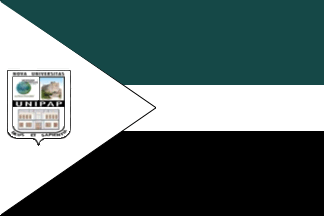 image by Ivan Sache, 9 January 2019
image by Ivan Sache, 9 January 2019
Universidad Panamericana del Puerto
(UNIPAP) was established in Puerto Cabello (Carabobo State) by Resolution
No. 152, adopted on 28 October 2003. UNIPAP is composed of 3 Faculties:
Engineering, Economical and Social Sciences, Education and Humanities.
The flag of UNIPAP was approved during the Ordinary Session No. 115 of
the University Council, held on 7 July 2009. The flag is horizontally divided
blue-white-black (c. 2:1:2) with a white triangle placed along the hoist and
charged with the university's emblem.
http://www.unipap.edu.ve/simbolos.html, UNIPAP website
Ivan Sache, 9 January 2019
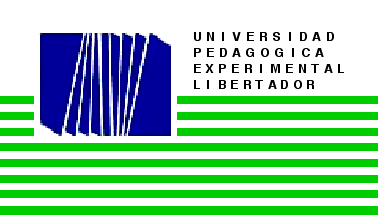 image by Ivan Sache, 10 August 2002
image by Ivan Sache, 10 August 2002
Universidad Pedagógica Experimental Libertador - The emblem
of the University was designed by the artist Alvaro Sotillo. It
is an abstract representation of nine books. Eight of these books
represent the eight Institutes which constitute the University,
and the ninth book represents the Rectoral Seat. In 1989, the
original grey colour of the books was changed to blue.
The flag has a white field with the emblem of the University in
upper left part and the name of the University beside it. In the
lower part of the flag, eight thin green stripes represent the
eight Institutes of the University. Green is the colour
traditionally associated to the Doctoral stuides in the UPEL.
UPEL was created by Decree #2176 of 28 July 1983 as an hommage to
Simon bolivar for the bicentenary of his birth.
Source: www.upel.edu.ve.
Ivan Sache, 10 August 2002
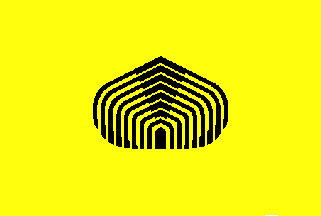 image by Raul Orta, 26 July 2002
image by Raul Orta, 26 July 2002
usb.gif) image by Raul Orta, 26 July
2002
image by Raul Orta, 26 July
2002
The Emblem
Based on www.usb.ve.
Dov Gutterman, 22 July 2002
The Flag - Attributes - The Simon Bolivar University is an
educative entity located on Sartenejas Valley, Sucre Municipality
of Miranda State, very near Caracas. It flag consists of a yellow
field of approximated ratio 2:3 or square and half of length,
with the Institute Official Emblem in black on the center.
Historical Synthesis - The SBU flag' design was made on 1972,
when a group of professors were dedicated to the work to
conceive the elements for bring the sport delegations with an
emblem. In that opportunity, it was decided by a yellow rectangle
with the Institute's Emblem in black on the center and underneath
this one the abbreviations USB (Universidad Simon Bolivar in
Spanish). Later, on June 1987, it was decided the elimination of
the abbreviations. The official flag of Simon Bolivar University
is hoisted near to the National Flag of Venezuela, in National
and Institutional holidays, in the Benjamín Mendoza Hall:
the most important of the campus, in sport delegations, student
groupings and the Firemen Body of the Institution.
The Emblem - Attributes and Semiology - The figure is made up
with eight semicircular lines and a small rectangle placed on the
center forming a structure similar to a rounded pyramid, whose
meaning is a porch in which it's made the unity of diverse
knowledge and its projection towards the future.
Historical Synthesis - From the existing confluence between the
name "Simon Bolivar University" and its motto "the
University of the Future", the designer Gerd Leufert made
the design of the Emblem being inspired by the photographic
reproduction of an electrical circuit.
Source: Simon Bolivar University Web Site www.usb.ve.
Raul Orta, 26 July 2002
The logo of the University was designed by Gerd Leufert. It is
based on the photographical representation of an electrical
circuit. The logo is made of eight semi-circular lines arranged
around a small rectangle. The logo constitutes a portico which
symbolizes the unity of the different sciences and their
projection into the future. The flag of the University was
designed in 1972 by a group of professors in order to give the
sport team a flag. The first flag was yellow with the logo of the
University and its acronym USB. The acronym was suppressed from
the flag in June 1987. The flag of the University is hoisted side
by side with the Venezuelian national flag for the national and
institutional days, in the Benjamin Mendoza Hall, by the sport
teams, student associations and the fire brigade of the
University.
Ivan Sache, 10 August 2002
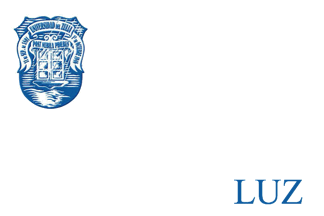 image by Ivan Sache, 29 July 2011
image by Ivan Sache, 29 July 2011
"Universidad del Zulia" (LUZ - "light" in Spanish) traces back to "Colegio
Nacional de Maracaibo", founded on 2 March 1837 by National Decree and
inaugurated on 19 April 1839. Closed in 1848 because of the political unrest,
the "Colegio" resumed its activity on 13 January 1850 with two classes in Latin
Grammar and Spanish Grammar; classes in Law, Medicine, Navigation (incl.
Cosmography, Trigonometry, Mathematics, Draftmanship and Philosophy) were added
in 1854. In 1864, the Federal Revolution transformed the Provinces into States;
the Maracaibo Province became the Zulia State and "Colegio Nacional de
Maracaibo" was renamed "Colegio Nacional del Zulia". On 17 September 1882, the
national colleges became federal colleges, so that "Colegio Nacional del Zulia"
was renamed "Colegio Federal del Zulia".
Following efficient lobbying by the Zulia Representatives Rafael López Baralt,
Francisco Eugenio Bustamante and Antonio Aranguren, the National Congress
upgraded on 29 May 1891 the "Colegio Federal del Zulia" to the "University del
Zulia", with a full university status. The new university was inaugurated on 11
September 1894. In 1897-1900, the university was directed by Francisco Eugenio
Bustamante, then considered as the best doctor and surgeon in the country, also
a liberal politician and a positivist scientist.
In 1904, the university was divided into the four Faculties of Political
Sciences, Medical Sciences, Pharmacy and Ecclesiastic Sciences. The first Gilded
Age of the university ended the same year, when the university was closed by
order of President Cipriano Castro and replaced by the "Instituto Náutico".
Castro believed that the two universities of Caracas and Mérida were enough for
training doctors,
lawyers, engineers and theologians, while technical institutes were required to
train the other students.
Oil was found in 1922 in Zulia, so that it replaced in 1926 coffee as the first
source of income in the state. A College of Political Sciences was founded in
Maracaibo on 13 August 1930 by National Decree. Its director, Jesús Enrique
Lossada, campaigned for the reopening of the University, which he eventually
obtained by a Decree of the Government Revolutionary Junta, signed on 15 June
1946. On 5 August 1946, Lossada was appointed Rector of LUZ, which then included
the three Faculties of Medicine, Engineering and Law.
Today, LUZ caters 51,600 students and 4,000 professors, spread over the three
campuses of Maracaibo, Cabimas and Punto Fijo. LUZ is organized in the 11
Faculties of Agronomy, Architecture and Design, Economic and Social Sciences,
Law and Political Sciences, Veterinary Sciences, Experimental Art, Experimental
Sciences, Humanities and Education, Engineering, Medicine and Odontology).
Source: Official website
The flag of LUZ is white with the coat of arms of the University in the upper
left corner and the letters "LUZ" in the lower right corner. White represents
the combination of the seven colors formed by light (Spanish, "luz") broken up
by a prism.
The coat of arms of LUZ was designed by Jesús Enrique Lossada, the first
director of LUZ after its reopening in 1946 - and, most probably, the inventor
of the "LUZ" abbreviation. The shield is elliptic, with a field deep sky blue
totally covered by small white clouds stretched in the horizontal direction. The
elements of the shield concur to symbolize that, in spite of 42 years of closure
and darkness, light ("luz"), truth and knowledge shine again. The shield has two
inscriptions indicating the dates of opening and reopening, and the Latin motto
"POST NUBILA PHOEBUS" (After the clouds, the sun - here personalized by the
Latin name of God Apollo).
Source: Official website
LUZ maintains a "bosque de banderas", that is a "forest of flags", made, from
viewer's left to right, of the following flags:
4. Law and Political Sciences (red)
 image by Ivan Sache, 29 July 2011
image by Ivan Sache, 29 July 2011
5. Medicine (light yellow)
 image by Ivan Sache, 29 July 2011
image by Ivan Sache, 29 July 2011
6. Engineering (blue)
 image by Ivan Sache, 29 July 2011
image by Ivan Sache, 29 July 2011
7. Odontology (purple)
 image by Ivan Sache, 29 July 2011
image by Ivan Sache, 29 July 2011
8. Economic and Social Sciences (fuchsia)
 image by Ivan Sache, 29 July 2011
image by Ivan Sache, 29 July 2011
9. Humanities and Education (gray)
 image by Ivan Sache, 29 July 2011
image by Ivan Sache, 29 July 2011
10. Agronomy (green)
 image by Ivan Sache, 29 July 2011
image by Ivan Sache, 29 July 2011
11. Architecture (light blue)
 image by Ivan Sache, 29 July 2011
image by Ivan Sache, 29 July 2011
12. Veterinary Sciences (dark yellow)
 image by Ivan Sache, 29 July 2011
image by Ivan Sache, 29 July 2011
13. Experimental Sciences (beige)
 image by Ivan Sache, 29 July 2011
image by Ivan Sache, 29 July 2011
14. Punto Fijo seat (water green)
 image by Ivan Sache, 29 July 2011
image by Ivan Sache, 29 July 2011
15. Cabimas seat (salmon)
 image by Ivan Sache, 29 July 2011
image by Ivan Sache, 29 July 2011
16. Experimental Arts (red wine)
 image by Ivan Sache, 29 July 2011
image by Ivan Sache, 29 July 2011
Sources:
Official leaflet
Photo of the "bosque de banderas", in reverse order (that is, rear view) -
as expected, the national flag is hoisted higher than the other flags.
Ivan Sache, 29 July 2011
1)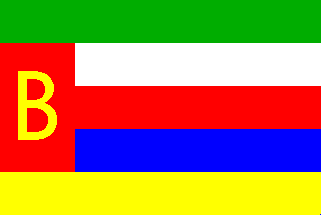 image by Guillermo T. Aveledo , 1 March 2000
image by Guillermo T. Aveledo , 1 March 2000
2)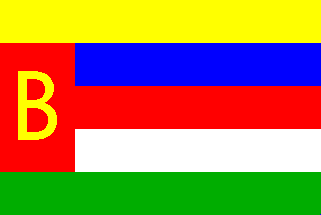 image by Guillermo T. Aveledo , 1 March 2000
image by Guillermo T. Aveledo , 1 March 2000
Sociedades Bolivarianas Estudiantiles (Student Bolivarian
Societies) - The SBCs are societies formed throughout Venezuela's
schools in order to honour and cherish the thought and work of
Venezuela's Liberator Simon Bolivar, who led (or intervened
protagonlly in) the wars of independance of six countries (or
countries to be) from Spanish rule: these countries are today's
Panama, Colombia, Venezuela (his birthplace), Ecuador, Bolivia
and Peru. These are the "bolivarian" countries (only
Venezuela has constitutionally declared itself a
"bolivarian" republic), whose flag colours serve as the
colours of the Student Bolivarian Societies flags: five stripes
of (from top to bottom or vice versa) yellow, blue, red, white and
green, with a yellow "B" on a red canton on the middle
of the hoist side, with the height of three of the stripes. These
flags are often seen in parades and on schoolyards.
I am not sure wether these flags are used in any of the other
"bolivarian" countries.
Guillermo T. Aveledo , 1 March 2000